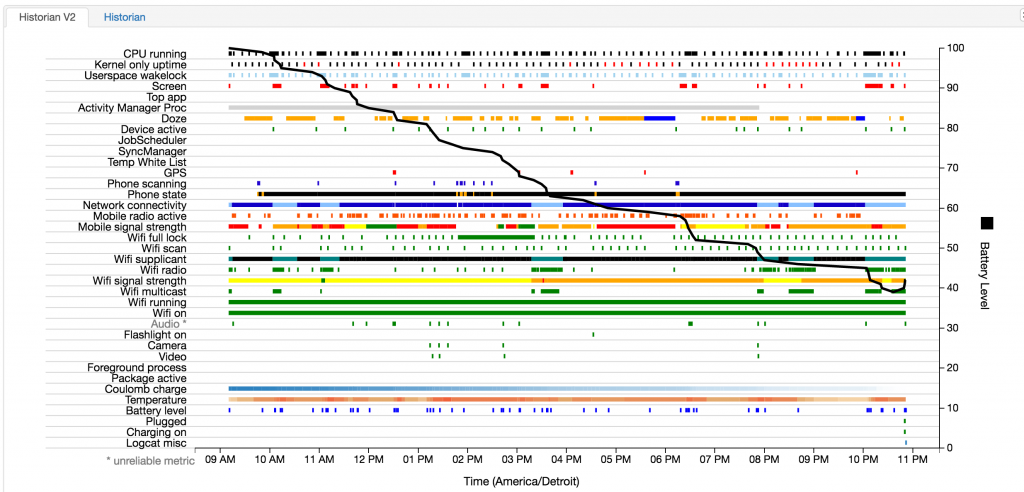One of my favorite apps prior to my upgrade to Android 7 (Nougat) was GSam Battery Monitor (the paid version is fully worth it). Unfortunately, Android 7 no longer allows apps like GSam Battery Monitor to track individual application battery usage, CPU usage, or wakelocks. That sucks*.
In Android 7 with Doze, you should see periods of marginal battery usage. The more apps you have, the more background services/sync operations/location broadcasts are running and you’ll see plateaus in battery usage be more slanted. Up until a few weeks ago, battery usage would basically flatline between screen time. I set out to figure out what was causing this. I found a thread on Reddit discussing Battery Historian, so I decided to check it out. This post is somewhat of a review of this tool.
Battery Historian analyzes bug report files and presents the information in an interactive graph with categorized breakdowns of battery usage. Battery Historian is a web application written in Go, and doesn’t appear to have an official release (binary or hosted). This means it’s basically limited to power users to evaluate. Since it’s licensed under Apache 2.0, I compiled and hosted this for my own use at https://historian.jimschubert.us/. Before using my hosted instance of Battery Historian, please heed Google’s warning about bug report files:
Bug reports contain data from the system’s various log files, including personal and private information. Only share bug reports with apps and people you trust.
Running Battery Historian locally isn’t too difficult. I definitely recommend going this route if you’re more of a power user; you don’t need programming experience, only comfort on the command line.
Once you’ve taken a bug report on your device and uploaded it to Battery Historian, you’re presented with a graph of all activity found in the bug report.
The declining black line is the same battery usage visualization you’d see in your Battery Usage application or widget. Other groups of battery draining events are presented as horizontal time-oriented lines; some are either on or off (screen), some show gradients for battery draining in the category (temperature), while others display different colors for different states of the event (Mobile signal strength).
Scroll below the graph and you’ll find a breakdown of system statistics. After a little sorting and investigation, I found that JuiceSSH had locked WiFi for 1.5 hours when I hadn’t used the application for over a week:
After selecting the JuiceSSH app in the left dropdown, this takes you to the App Stats tab which presents some interesting battery usage statistics:
Wakelocks:
Wakelock Name | Full Time | Full Count | Partial Time | Partial Count | Window Time | Window Count
JuiceSSH CloudSync | | 0 | 8m 0s 50ms | 1 | | 0
*alarm* | | 0 | 684ms | 1 | | 0
Services:
Service Name | Time spent started | # starts | # launches
com.sonelli.juicessh.services.CloudSync | 2h 28m 15s 789ms | 1 | 1
Process info:
Time spent running actively in the foreground | 0ms
Time spent with a service running in the foreground | 0ms
Time spent on top | 0ms
Time spent on top while the device was sleeping | 0ms
Time spent running actively in the background | 1h 33m 10s 343ms
Time spent cached | 38ms
Looks like, in my case, JuiceSSH Cloud Sync had 8 minutes worth of wakelocks, 2.5 hours of a service running in which 1.5 hours of that was actively running in the background. JuiceSSH unfortunately doesn’t have configuration options for Cloud Sync, so I’ve disabled it. I’ve noticed an improvement since disabling JuiceSSH Cloud Sync.
Although I was a little miffed that the Android 7 update borked GSam’s ability to report on per-application usage, I found Battery Historian to be a really insightful tool. From and Android Development perspective it would be a nice utility to evaluate your application’s effect on the system through normal use. It may be a little overkill from a user or power user’s perspective, though. My Nexus 5X was getting about 18 hours of pretty heavy usage (including my son watching YouTube videos). After disabling JuiceSSH Cloud Sync, I’m seeing about 20 hours of battery out of the same usage. Does that really matter if you’re like me and you charge your phone every night? 👻
- I’ve read that GSam Battery Monitor with root still works as expected on Nougat.

